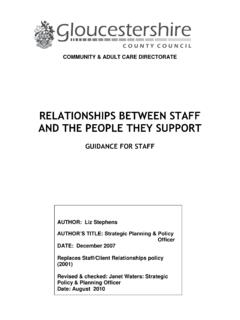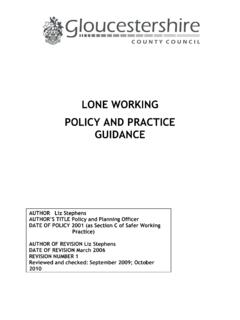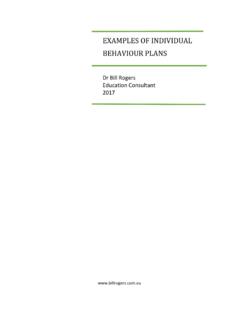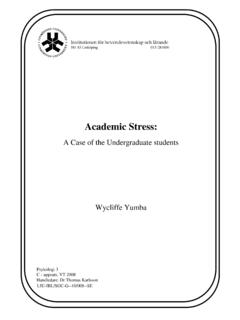Transcription of Unconscious Bias: How Might It Affect Social Work
1 Home Resources Reports Unconscious bias : How Might It Affect Social work Evelyn Chafota 02 December 2020 In recent months, the Black Lives Matter protests have cast a spotlight on implicit or Unconscious bias . While these protests raised awareness of the inequitable treatment of Black people by police officers and hence the issue of racism Unconscious bias is an inescapable fact of life for us all, permeating all areas of our work and Social lives. Although health and Social workers are taught to respect and accept cultural diversity, our inherent Unconscious bias unfortunately often seeps out, clouding judgements and affecting decision-making.
2 In other words, Unconscious bias impacts upon our objectivity and can create barriers to the effective engagement of certain groups of people accessing Social services. So, what exactly is Unconscious bias , how Might it Affect our decision-making, and, more importantly, what can be done about it? This article provides an overview of the topic and how it can impact on Social work practice. Understanding Unconscious bias Our brains have the capacity to handle a huge amount of data, with one estimate suggesting that up to 11 million pieces of information are unconsciously processed every second.
3 In contrast, it seems that our brains can only consciously process a measly 40 pieces of information per The implication of this discrepancy is clear, indicating that a huge amount of data processing in our mind is essentially automatic and without conscious intervention. The idea that most of our brain s processing of information is Unconscious was a central construct of Sigmund Freud s psychoanalytical theory of personality in the 1880s. Freud advanced the notion that the Unconscious mind served as a reservoir of feelings, thoughts and urges that were outside the realms of conscious awareness.
4 This was further highlighted by psychologist Daniel Kahneman in his book, Thinking Fast and Slow2 in which he conceptualised that the thinking processes within our brains was compartmentalised into two distinct systems, which he termed system 1 and 2. An activity such as walking or speaking are, to all intents and purposes, automatic and require little conscious input and were expedited via system 1. In contrast, the activities governed by system 2 evolved more slowly and required some degree of conscious input , problem solving, reasoning etc.
5 Freud believed that many of our beliefs, feelings and desires are repressed, but on occasions can accidently become expressed, hence the idea of a Freudian slip. System 1 thinking continually guides our thought processes, attitudes, and beliefs but without our realising, and arises from the experiences of various cues gained from family, school, work cultures etc. The exposure to these different signals strongly influence our view of the world and lead to the formation of Unconscious associations. Indeed, part of the brain s learning process involves the connection of items together (based on our experiences), leading to the creation of neural pathways that are laid down and ultimately strengthened, each time that same connection is made.
6 These pathways are largely reliant upon stereotyping and operate independent of someone s intent. According to Martin et al,3 a stereotype can be perceived as a template-like cognitive representation, in which the membership of certain groups are associated with specific attributes. The stereotype provides the brain with an easily recognisable relationship, thus easing the cognitive burden. For instance, the repeated observation of white swans, serves to strengthen the existing neural pathways and creates the stereotype of a swan, which is a white coloured bird.
7 The appearance of a black swan however, provides ambiguous evidence which immediately challenges our pre-existing stereotype. In practice, a consequence of this over-reliance on the Unconscious amalgamation of various cues is that since a stereotype is created at a cost to accuracy, deviations from the imagery laid down in the neural circuitry can influence our response to these anomalies and precipitate unintended and discriminatory behaviour. This is termed implicit or Unconscious bias and has been described by Narayan4 as the tendency for people to harbour negative stereotypes or make judgements about another group.
8 In fact Unconscious bias is often triggered automatically when encountering different situations or people, without an individual s full awareness and control. According to Kahneman,2 Unconscious bias is rooted in availability heuristics, which represents the mental shortcuts used to create a stereotype. It is a form of cognitive bias or systematic error, which occurs when individuals attempt to process and interpret the information they receive. The pervasiveness of Unconscious bias As an effective blind spot, it can be difficult for an individual to see past their Unconscious bias , though it will continually influence their actions.
9 Unconscious bias has been extensively studied in an attempt to understand the origins of racial prejudice and implicit attitudes ( , those which arise from Unconscious bias ). In an attitudinal study, Dovidio5 showed that White individuals self-reported racial attitudes significantly predicted bias in the verbal behaviour to Black versus other White individuals. Although today most individuals would condemn overt bigotry, this does not mean that it has been eliminated, but that it has become more nuanced. In a disturbing recent study, Okonofua6 examined Unconscious bias in school discipline in the US, in particular in relation to punishment of Black versus White students.
10 The study revealed how teachers Unconscious bias associated with race lead to them being more likely to assign a harsh punishment for repeated misbehaviour to a student they thought was Black rather than White. Moreover, Unconscious bias rears its head in the criminal justice system. According to a recent report, people from a BAME background are almost three times more likely than White people to be stopped and searched, and that for every 100 White women given a custodial sentence for drug offences, 227 Black women are incarcerated for the same Nevertheless, Unconscious bias is pervasive in society and not restricted to racial prejudice, extending to gender, sexual orientation, disability and any other number of aspects of identity.













